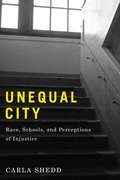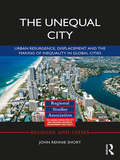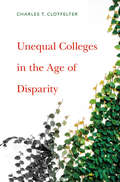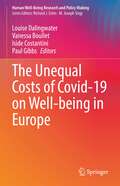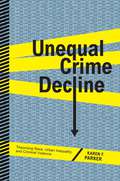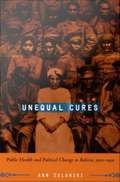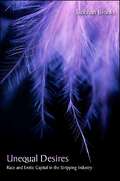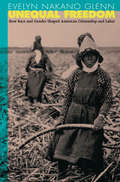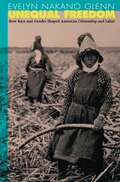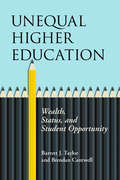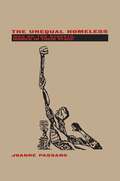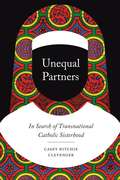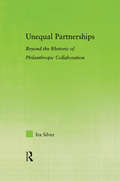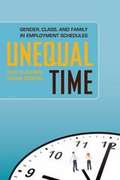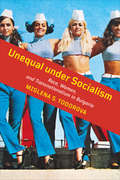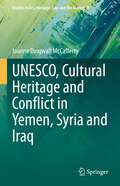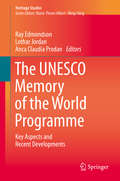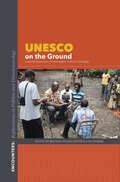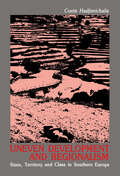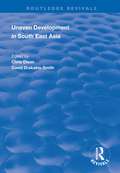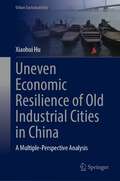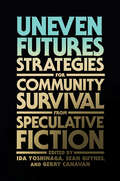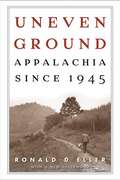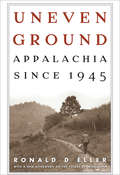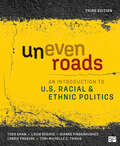- Table View
- List View
Unequal City: Race, Schools, and Perceptions of Injustice
by Carla SheddChicago has long struggled with racial residential segregation, high rates of poverty, and deepening class stratification, and it can be a challenging place for adolescents to grow up. Unequal City examines the ways in which Chicago’s most vulnerable residents navigate their neighborhoods, life opportunities, and encounters with the law. In this pioneering analysis of the intersection of race, place, and opportunity, sociologist and criminal justice expert Carla Shedd illuminates how schools either reinforce or ameliorate the social inequalities that shape the worlds of these adolescents. Shedd draws from an array of data and in-depth interviews with Chicago youth to offer new insight into this understudied group. Focusing on four public high schools with differing student bodies, Shedd reveals how the predominantly low-income African American students at one school encounter obstacles their more affluent, white counterparts on the other side of the city do not face. Teens often travel long distances to attend school which, due to Chicago’s segregated and highly unequal neighborhoods, can involve crossing class, race, and gang lines. As Shedd explains, the disadvantaged teens who traverse these boundaries daily develop a keen “perception of injustice,” or the recognition that their economic and educational opportunities are restricted by their place in the social hierarchy. Adolescents’ worldviews are also influenced by encounters with law enforcement while traveling to school and during school hours. Shedd tracks the rise of metal detectors, surveillance cameras, and pat-downs at certain Chicago schools. Along with police procedures like stop-and-frisk, these prison-like practices lead to distrust of authority and feelings of powerlessness among the adolescents who experience mistreatment either firsthand or vicariously. Shedd finds that the racial composition of the student body profoundly shapes students’ perceptions of injustice. The more diverse a school is, the more likely its students of color will recognize whether they are subject to discriminatory treatment. By contrast, African American and Hispanic youth whose schools and neighborhoods are both highly segregated and highly policed are less likely to understand their individual and group disadvantage due to their lack of exposure to youth of differing backgrounds.
The Unequal City: Urban Resurgence, Displacement and the Making of Inequality in Global Cities
by John Rennie ShortCities around the world have seen: an increase in population and capital investments in land and building; a shift in central city populations as the poor are forced out; and a radical restructuring of urban space. The Unequal City tells the story of urban change and acts as a comprehensive guide to the Urban Now. A number of trends are examined, including: the role of liquid capital; the resurgence of population; the construction of megaprojects and hosting of global megaevents; the role of the new rich; and the emergence of a new middle class. This book explores the reasons behind the displacement of the poor to the suburbs and beyond. Drawing upon case studies from around the world, readers are exposed to an examination of the urban projects that involve the reuse of older industrial spaces, the greening of the cities, and the securitization of the public spaces. This book draws on political economy, cultural and political analysis, and urban geography approaches in order to consider the multifaceted nature of the process and its global unfolding. It will be essential reading to those interested in urban studies, economic geography, urban economics, urban sociology, urban planning and globalization.
Unequal Colleges in the Age of Disparity
by Charles T. ClotfelterBased on quantitative comparisons of colleges since the 1970s, Charles Clotfelter reveals that despite the civil rights revolution, billions spent on financial aid, and the commitment of colleges to greater equality, stratification in higher education has grown starker. He explains why undergraduate education—unequal in 1970—is even more so today.
The Unequal Costs of Covid-19 on Well-being in Europe (Human Well-Being Research and Policy Making)
by Louise Dalingwater Vanessa Boullet Iside Costantini Paul GibbsThis volume focuses on the wider wellbeing costs within European countries as a result of the outbreak of the pandemic and the control measures implemented thereafter. In particular, it considers to what extent Covid-19 and measures taken to cope with the crisis have weakened economic and social structures across Europe and what effect this has had on people’s lives. While many countries in Europe have reallocated public funding to health care, provided support to SMEs, vulnerable populations and regions hit by the crisis, the wellbeing or welfare costs, considered broadly, are still significant. The authors' assessment thus goes beyond the subjective wellbeing discourse and evaluates to what extent structural weaknesses within economic, social and regional frameworks have deepened. The chapters discuss what policies are needed to address these weaknesses. the volume thus recognises that structural inequalities are a key driver of wellbeing. While there have been a number of publications on wellbeing during the pandemic, the original perspective in each chapter on inequalities and the European focus of this publication provide novel information and insights on the topic.
Unequal Crime Decline: Theorizing Race, Urban Inequality, and Criminal Violence
by Karen F. Parker2009 Choice Outstanding Academic TitleCrime in most urban areas has been falling since 1991. While the decline has been well-documented, few scholars have analyzed which groups have most benefited from the crime decline and which are still on the frontlines of violence--and why that might be. In Unequal Crime Decline, Karen F. Parker presents a structural and theoretical analysis of the various factors that affect the crime decline, looking particularly at the past three decades and the shifts that have taken place, and offers original insight into which trends have declined and why.Taking into account such indicators as employment, labor market opportunities, skill levels, housing, changes in racial composition, family structure, and drug trafficking, Parker provides statistics that illustrate how these factors do or do not affect urban violence, and carefully considers these factors in relation to various crime trends, such as rates involving blacks, whites, but also trends among black males, white females, as well as others. Throughout the book she discusses popular structural theories of crime and their limitations, in the end concentrating on today's issues and important contemporary policy to be considered. Unequal Crime Decline is a comprehensive and theoretically sophisticated look at the relationship among race, urban inequality, and violence in the years leading up to and following America's landmark crime drop.
Unequal Cures: Public Health and Political Change in Bolivia, 1900-1950
by Ann ZulawskiUnequal Cures illuminates the connections between public health and political change in Bolivia from the beginning of the twentieth century, when the country was a political oligarchy, until the eve of the 1952 national revolution that ushered in universal suffrage, agrarian reform, and the nationalization of Bolivia's tin mines. Ann Zulawski examines both how the period's major ideological and social transformations changed medical thinking and how ideas of public health figured in debates about what kind of country Bolivia should become. Zulawski argues that the emerging populist politics of the 1930s and 1940s helped consolidate Bolivia's medical profession and that improved public health was essential to the creation of a modern state. Yet she finds that at mid-century, women, indigenous Bolivians, and the poor were still considered inferior and consequently received often inadequate medical treatment and lower levels of medical care. Drawing on hospital and cemetery records, censuses, diagnoses, newspaper accounts, and interviews, Zulawski describes the major medical problems that Bolivia faced during the first half of the twentieth century, their social and economic causes, and efforts at their amelioration. Her analysis encompasses the Rockefeller Foundation's campaign against yellow fever, the almost total collapse of Bolivia's health care system during the disastrous Chaco War with Paraguay (1932-35), an assessment of women's health in light of their socioeconomic realities, and a look at Manicomio Pacheco, the national mental hospital.
Unequal Desires: Race and Erotic Capital in the Stripping Industry
by Siobhan BrooksWinner of the 2008 SUNY Press Dissertation/First Book Prize in Queer Studies, this groundbreaking ethnographic study of racial stratification in queer and straight strip clubs examines the lives and working conditions of Black and Latina dancers in strip clubs in New York City and Oakland, California. Though interviews with dancers, customers, managers, boucers, and other strip club employees, Siobhan Brooks explores the connections between race, desire, and commodification in what she terms "desire industries." The study finds that even in times of economic gains for a minority of Black and Latino/a middle-class populations, sexual stereotypes and racial hypersexualization continue to affect many women of color who work in the sex industry, leading to more exposure to violence, wage gaps, and less access to more lucrative shifts and performance venues. Through her insightful and illuminating analysis, Brooks makes the case that racialized erotic capital is central to what owners think will sell, what customers will buy, how dancers negotiate those desire landscapes, and the male and female consumption of desire.
Unequal Freedom: How Race And Gender Shaped American Citizenship And Labor
by Evelyn Nakano GlennThe inequalities that persist in America have deep historical roots. Evelyn Nakano Glenn untangles this complex history in a unique comparative regional study from the end of Reconstruction to the eve of World War II. During this era the country experienced enormous social and economic changes with the abolition of slavery, rapid territorial expansion, and massive immigration, and struggled over the meaning of free labor and the essence of citizenship as people who previously had been excluded sought the promise of economic freedom and full political rights. <p><p> After a lucid overview of the concepts of the free worker and the independent citizen at the national level, Glenn vividly details how race and gender issues framed the struggle over labor and citizenship rights at the local level between blacks and whites in the South, Mexicans and Anglos in the Southwest, and Asians and haoles (the white planter class) in Hawaii. She illuminates the complex interplay of local and national forces in American society and provides a dynamic view of how labor and citizenship were defined, enforced, and contested in a formative era for white-nonwhite relations in America.
Unequal Freedom: How Race and Gender Shaped American Citizenship and Labor
by Evelyn Nakano GlennThe inequalities that persist in America have deep historical roots. Evelyn Nakano Glenn untangles this complex history in a unique comparative regional study from the end of Reconstruction to the eve of World War II. During this era the country experienced enormous social and economic changes with the abolition of slavery, rapid territorial expansion, and massive immigration, and struggled over the meaning of free labor and the essence of citizenship as people who previously had been excluded sought the promise of economic freedom and full political rights. After a lucid overview of the concepts of the free worker and the independent citizen at the national level, Glenn vividly details how race and gender issues framed the struggle over labor and citizenship rights at the local level between blacks and whites in the South, Mexicans and Anglos in the Southwest, and Asians and haoles (the white planter class) in Hawaii. She illuminates the complex interplay of local and national forces in American society and provides a dynamic view of how labor and citizenship were defined, enforced, and contested in a formative era for white-nonwhite relations in America.
Unequal Higher Education: Wealth, Status, and Student Opportunity (The American Campus)
by Barrett J. Taylor Brendan CantwellAmerican higher education is often understood as a vehicle for social advancement. However, the institutions at which students enroll differ widely from one another. Some enjoy tremendous endowment savings and/or collect resources via research, which then offsets the funds that students contribute. Other institutions rely heavily on student tuition payments. These schools may struggle to remain solvent, and their students often bear the lion’s share of educational costs. Unequal Higher Education identifies and explains the sources of stratification that differentiate colleges and universities in the United States. Barrett J. Taylor and Brendan Cantwell use quantitative analysis to map the contours of this system. They then explain the mechanisms that sustain it and illustrate the ways in which rising institutional inequality has limited individual opportunity, especially for students of color and low-income individuals.
The Unequal Homeless: Men on the Streets, Women in their Place
by Joanne PassaroThe Unequal Homeless explores the persistence, as opposed to the occurrence, of homelessness. With this focus, which is absent in most of the contemporary homelessness literature, the author shows how cultural expressions of beliefs about gender difference help to perpetuate the homelessness of particular groups of people in New York City. The people who are persistently homeless in New York are, overwhelmingly, black men. The reason, Passaro contends, is that homelessness is not simply an economic predicament, but a cultural and moral location as well.
Unequal Partners: In Search of Transnational Catholic Sisterhood
by Casey Ritchie ClevengerWhen we think of Catholicism, we think of Europe and the United States as the seats of its power. But while much of Catholicism remains headquartered in the West, the Church’s center of gravity has shifted to Africa, Latin America, and developing Asia. Focused on the transnational Sisters of Notre Dame de Namur, Unequal Partners explores the ways gender, race, economic inequality, and colonial history play out in religious organizations, revealing how their members are constantly negotiating and reworking the frameworks within which they operate. Taking us from Belgium and the United States to the Democratic Republic of the Congo, sociologist Casey Clevenger offers rare insight into how the sisters of this order work across national boundaries, shedding light on the complex relationships among individuals, social groups, and formal organizations. Throughout, Clevenger skillfully weaves the sisters’ own voices into her narrative, helping us understand how the order has remained whole over time. A thoughtful analysis of the ties that bind—and divide—the sisters, Unequal Partners is a rich look at transnationalism’s ongoing impact on Catholicism.
Unequal Partnerships: Beyond the Rhetoric of Philanthropic Collaboration (New Approaches in Sociology)
by Ira SilverThrough an examination of the Chicago Initiative, Silver analyzes how elite philanthropists exercise social control over community organizations that do work in poor neighborhoods.
Unequal Time: Gender, Class, and Family in Employment Schedules
by Dan Clawson Naomi GerstelLife is unpredictable. Control over one’s time is a crucial resource for managing that unpredictability, keeping a job, and raising a family. But the ability to control one’s time, much like one’s income, is determined to a significant degree by both gender and class. In Unequal Time, sociologists Dan Clawson and Naomi Gerstel explore the ways in which social inequalities permeate the workplace, shaping employees’ capacities to determine both their work schedules and home lives, and exacerbating differences between men and women, and the economically privileged and disadvantaged. Unequal Time investigates the interconnected schedules of four occupations in the health sector—professional-class doctors and nurses, and working-class EMTs and nursing assistants. While doctors and EMTs are predominantly men, nurses and nursing assistants are overwhelmingly women. In all four occupations, workers routinely confront schedule uncertainty, or unexpected events that interrupt, reduce, or extend work hours. Yet, Clawson and Gerstel show that members of these four occupations experience the effects of schedule uncertainty in very distinct ways, depending on both gender and class. But doctors, who are professional-class and largely male, have significant control over their schedules and tend to work long hours because they earn respect from their peers for doing so. By contrast, nursing assistants, who are primarily female and working-class, work demanding hours because they are most likely to be penalized for taking time off, no matter how valid the reasons. Unequal Time also shows that the degree of control that workers hold over their schedules can either reinforce or challenge conventional gender roles. Male doctors frequently work overtime and rely heavily on their wives and domestic workers to care for their families. Female nurses are more likely to handle the bulk of their family responsibilities, and use the control they have over their work schedules in order to dedicate more time to home life. Surprisingly, Clawson and Gerstel find that in the working class occupations, workers frequently undermine traditional gender roles, with male EMTs taking significant time from work for child care and women nursing assistants working extra hours to financially support their children and other relatives. Employers often underscore these disparities by allowing their upper-tier workers (doctors and nurses) the flexibility that enables their gender roles at home, including, for example, reshaping their workplaces in order to accommodate female nurses’ family obligations. Low-wage workers, on the other hand, are pressured to put their jobs before the unpredictable events they might face outside of work. Though we tend to consider personal and work scheduling an individual affair, Clawson and Gerstel present a provocative new case that time in the workplace also collective. A valuable resource for workers’ advocates and policymakers alike, Unequal Time exposes how social inequalities reverberate through a web of interconnected professional relationships and schedules, significantly shaping the lives of workers and their families.
Unequal under Socialism: Race, Women, and Transnationalism in Bulgaria
by Miglena S. TodorovaUnequal under Socialism examines the formation of racial, gender, and national identities and relations in the socialist state. With a specific focus on Bulgaria, a former socialist country in the Balkans, Miglena S. Todorova traces the intertwined local and global forces driving racialization, socialist state policies, and Eurocentric Marxist and Leninist ideologies, all of which led to valued and devalued categories of women. Roma women, Muslim women, ethnic Bulgarian women, sex workers, and female factory and office workers were among those marked by socialist authorities for prosperity, accommodation, violent reformation, or erasure. Covering the period from the 1930s to the present and drawing upon original archival sources as well as a constellation of critical theories, Unequal under Socialism focuses on the lives of different women to articulate deep doubt about the capacity of socialism to sustain societies where all women prosper. Such doubt, the book suggests, is an under-recognized but important force shaping how women in former socialist countries have related to one another and to other women in the global North and South.
UNESCO, Cultural Heritage and Conflict in Yemen, Syria and Iraq (Studies in Art, Heritage, Law and the Market #8)
by Joanne Dingwall McCaffertyThis book aims to determine UNESCO's capability to facilitate heritage protection measures pre-conflict, emergency response measures during conflict and reconstruction efforts post-conflict. The book employs document analysis to ascertain UNESCO's legal obligations when it comes to facilitating cultural heritage protection in its Member States' territories in the condition of armed conflict, while drawing comparisons with the reality of the organisation's presence and involvement in Yemen, Syria and Iraq. This study maps shifts in UNESCO's level of communication with each country's respective government and civil authorities; allocation of financial, human and material resources; and implementation of heritage safeguarding and reconstruction initiatives. Both quantitative and qualitative data shows UNESCO to exhibit great inequity in engagement, at times, closing communications entirely with Syria, due to the political standpoints of other UNESCO Member States. This political gridlock is often shown to result in the organisation overstating its ability to safeguard or restore heritage, with promises not being followed up with action. Since 2015, UNESCO has expressed a stronger intent to be a key player in heritage protection during armed conflict, however as long as cultural heritage protection is not considered a humanitarian concern, UNESCO will not be able to circumvent much of the political and bureaucratic barriers facing intergovernmental organisations during conflict, which prevent emergency action from being implemented. In order to ensure heritage safeguarding is permitted during periods of significant unrest, regardless of political discord, it is crucial that UNESCO promote a people-centred approach to its cultural heritage protection initiatives. This book evidences that focusing on livelihoods and meaningful and practical connections between populations and their local heritage to be UNESCO's optimal methodological approach for justifying cultural heritage protection as a humanitarian necessity. The book's readership includes academics, researchers, and practitioners in the fields of political science, law and heritage studies.
The UNESCO Memory of the World Programme: Key Aspects and Recent Developments (Heritage Studies)
by Ray Edmondson Lothar Jordan Anca Claudia ProdanThe volume “The UNESCO Memory of the World Programme: Key Aspects and Recent Developments” responds to the growing interest in the scientific study of the Memory of the World Programme (MoW) and its core concept of documentary heritage, which has received little attention from scholarship so far. This sixth publication in the Heritage Studies Series provides a first collection of differing approaches (including reflected reports, essays, research contributions, and theoretical reflections) for the study of the MoW Programme, offering a basis for follow-up activities. The volume, edited by Ray Edmondson, Lothar Jordan and Anca Claudia Prodan, brings together 21 scholars from around the globe to present aspects deemed crucial for understanding MoW, its development, relevance and potential. The aim is to encourage academic research on MoW and to enhance the understanding of its potential and place within Heritage Studies and beyond.
UNESCO on the Ground: Local Perspectives On Intangible Cultural Heritage (Encounters: Explorations In Folklore And Ethnomusicology Ser.)
by Lisa Gilman Michael Dylan FosterFor nearly 70 years, the United Nations Educational, Scientific and Cultural Organization (UNESCO) has played a crucial role in developing policies and recommendations for dealing with intangible cultural heritage. What has been the effect of such sweeping global policies on those actually affected by them? How connected is UNESCO with what is happening every day, on the ground, in local communities? Drawing upon six communities ranging across three continents--from India, South Korea, Malawi, Japan, Macedonia and China--and focusing on festival, ritual, and dance, this volume illuminates the complexities and challenges faced by those who find themselves drawn, in different ways, into UNESCO's orbit. Some struggle to incorporate UNESCO recognition into their own local understanding of tradition; others cope with the fallout of a failed intangible cultural heritage nomination. By exploring locally, by looking outward from the inside, the essays show how a normative policy such as UNESCO's intangible cultural heritage policy can take on specific associations and inflections. A number of the key questions and themes emerge across the case studies and three accompanying commentaries: issues of terminology; power struggles between local, national and international stakeholders; the value of international recognition; and what forces shape selection processes. With examples from around the world, and a balance of local experiences with broader perspectives, this volume provides a unique comparative approach to timely questions of tradition and change in a rapidly globalizing world.
Uneven Development and Regionalism: State, Territory and Class in Southern Europe
by Costis HadjimichalisPublished in the year 1986, Uneven Development and Regionalism is a valuable contribution to the field of Geography.
Uneven Development in South East Asia (Routledge Revivals)
by Chris Dixon David Drakakis-SmithFirst published in 1997, this volume responds to the rapid change in mid-1980s South East Asia, exploring the uneven distribution of development within the region and providing broad coverage of different aspects of this unevenness at both the regional and national levels. Specialists in economics, geography, planning and South East Asian studies contribute on issues including ethnicity and development in Malaysia, disadvantaged groups in Singapore and the impact of social and historical forces on uneven development in the region.
Uneven Economic Resilience of Old Industrial Cities in China: A Multiple-Perspective Analysis (Urban Sustainability)
by Xiaohui HuTaking the Chinese context seriously, this book provides critical reflections and policy-informed accounts of how and why old industrial cities generate uneven resilience in the face of crisis. It offers unconventional conceptualizations and on-the-ground empirical studies in the Chinese context when it comes to the literature on regional economic resilience. Theoretically, this book adopts multiple perspectives, including evolutionary, complex adaptive systems, and institutional and geographical political economy, to provide a more systematic understanding of regional economic resilience in Chinese old industrial cities. Empirically, this book adopts a comparative analysis approach to explore the in-depth nature of uneven regional economic resilience by focusing on two coal mining regions in China. The book also makes an additional and timely academic contribution to the literature on the conceptualization and empirics of regional economic resilience under the COVID-19 pandemic crisis. This book is suitable for undergraduate and graduate students and scholars interested in economic geography in general and regional economic resilience, regional industrial dynamics and old industrial cities in China in particular. It is also a useful reference for local and regional governments, as well as businesses, for policy-making and action in the face of crisis.
Uneven Futures: Strategies for Community Survival from Speculative Fiction
by Ida Yoshinaga Sean Guynes Gerry CanavanEssays on speculative/science fiction explore the futures that feed our most cherished fantasies and terrifying nightmares, while helping diverse communities devise new survival strategies for a tough millennium.The explosion in speculative/science fiction (SF) across different media from the late twentieth century to the present has compelled those in the field of SF studies to rethink the community&’s identity, orientation, and stakes. In this edited collection, more than forty writers, critics, game designers, scholars, and activists explore core SF texts, with an eye toward a future in which corporations dominate both the means of production and the means of distribution and governments rely on powerful surveillance and carceral technologies. The essays, international in scope, demonstrate the diversity of SF through a balance of popular mass-market novels, comics, films, games, TV shows, creepypastas, and more niche works. SF works explored range from Riot Baby by Tochi Onyebuchi, 2084: The End of the World by Boualem Sansal, Terra Nullius by Claire Coleman, Watchmen and X-Men comics, and the Marvel film Captain America: The Winter Soldier, to the MaddAddam trilogy by Margaret Atwood, The Dispossessed by Ursula K. Le Guin, The Wandering Earth by Liu Cixin, and the Wormwood trilogy by Tade Thompson. In an era in which ecological disaster and global pandemics regularly expose and intensify deep political-economic inequalities, what futures has SF anticipated? What survival strategies has it provided us? Can it help us to deal with, and grow beyond, the inequalities and injustices of our times? Unlike other books of speculative/science fiction criticism, Uneven Futures uses a think piece format to make its critical insights engaging to a wide audience. The essays inspire visions of better possible futures—drawing on feminist, queer, and global speculative engagements with Indigenous, Latinx, and Afro- and African futurisms—while imparting important lessons for political organizing in the present.Contributors: Ben Abraham, Emmet Asher-Perrin, Brent Ryan Bellamy, Gerry Canavan, Andrew Ferguson, Fabio Fernandes, Dexter Gabriel, M. Elizabeth Ginway, Sean Guynes, Ouissal Harize, David M. Higgins, Veronica Hollinger, Allanah Hunt, Nicola Hunte, Nathaniel Isaacson, Ayana Jamieson, Darshana Jayemanne, Gwyneth Jones, Brendan Keogh, Sami Ahmad Khan, Cameron Kunzelman, Bryan Kamaoli Kuwada, Isiah Lavender III, Caryn Lesuma, Karen Lord, Sarah Marrs, Farah Mendlesohn, Cathryn Merla-Watson, Hugh Charles O&’Connell, B. Pladek, John Rieder, Lysa Rivera, Kim Stanley Robinson, Steven Shaviro, Rebekah Sheldon, Alison Sperling, Alfredo Suppia, Bogi Takács, Taryne Jade Taylor, Sherryl Vint, Kirin Wachter-Grene, Ida Yoshinaga.
Uneven Ground: Appalachia Since 1945
by Ronald D EllerAppalachia has played a complex and often contradictory role in the unfolding of American history. Created by urban journalists in the years following the Civil War, the idea of Appalachia provided a counterpoint to emerging definitions of progress. Early-twentieth-century critics of modernity saw the region as a remnant of frontier life, a reflection of simpler times that should be preserved and protected. However, supporters of development and of the growth of material production, consumption, and technology decried what they perceived as the isolation and backwardness of the place and sought to "uplift" the mountain people through education and industrialization. <P><P>Ronald D Eller has worked with local leaders, state policymakers, and national planners to translate the lessons of private industrial-development history into public policy affecting the region. In Uneven Ground: Appalachia since 1945, Eller examines the politics of development in Appalachia since World War II with an eye toward exploring the idea of progress as it has evolved in modern America. Appalachia's struggle to overcome poverty, to live in harmony with the land, and to respect the diversity of cultures and the value of community is also an American story. In the end, Eller concludes, "Appalachia was not different from the rest of America; it was in fact a mirror of what the nation was becoming."
Uneven Ground: Appalachia Since 1945
by Ronald D. EllerThis award-winning history examines the politics of progress in America through a close look at industrial development in Appalachia since WWII.Appalachia has played a complex role in the unfolding of American history. Early-twentieth-century critics of modernity saw the region as a remnant of frontier life that should be preserved and protected. However, supporters of material production and technology decried what they saw as a the isolation and backwardness of the region and sought to “uplift” its people through education and industrialization.In Uneven Ground, Ronald D. Eller examines the politics of development in Appalachia while exploring the idea of progress as it has evolved in America. “Passionate, clear, concise, and at times profound,” this volume demonstrates that Appalachia's struggle to overcome poverty, to live in harmony with the land, and to respect the value of community is a truly American story (Chad Berry, author of Southern Migrants, Northern Exiles).Winner of the Appalachian Studies Association’s Weatherford Awardand the Southern Political Science Association’s V.O. Key Award
Uneven Roads: An Introduction to U.S. Racial and Ethnic Politics
by Todd Shaw Louis Desipio Dianne Pinderhughes Lorrie Frasure Toni-Michelle C. TravisUneven Roads helps students grasp how, when, and why race and ethnicity matter in U.S. politics. Using the metaphor of a road, with twists, turns, and dead ends, this incisive text takes students on a journey to understanding political racialization and the roots of modern interpretations of race and ethnicity. The book’s structure and narrative are designed to encourage comparison and reflection. Students critically analyze the history and context of U.S. racial and ethnic politics to build the skills needed to draw their own conclusions. In the Third Edition of this groundbreaking text, authors Shaw, DeSipio, Pinderhughes, Frasure, and Travis bring the historical narrative to life by addressing the most contemporary debates and challenges affecting U.S. racial and ethnic politics. Students will explore important issues regarding voting rights, political representation, education and criminal justice policies, and the immigrant experience.
